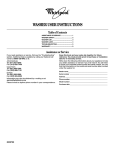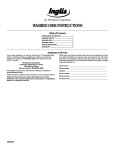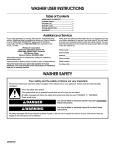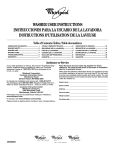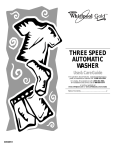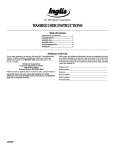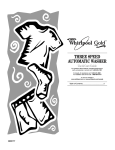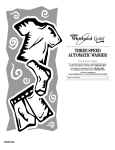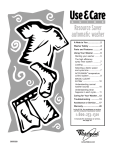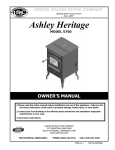Download Whirlpool 8TLSQ8533LT1 User's Manual
Transcript
® WASHER USER INSTRUCTIONS Table of Contents ASSISTANCE OR SERVICE ............................ 1 WASHER SAFETY............................................ 2 WASHER USE .................................................. 3 WASHER CARE................................................ 4 TROUBLESHOOTING...................................... 5 ..................................................... 7 ........................................................ 7 ................................................. 8 ...................................................... 10 .......................................................... 10 Assistance or Service Before calling for assistance or service, please check “Troubleshooting.” It may save you the cost of a service call. If you still need help, contact the dealer from whom you purchased the washer, or a Whirlpool designated service company. When calling, please know the purchase date and the complete model and serial number of your appliance. This information will help us to better respond to your request. If you need replacement parts If you need to order replacement parts, we recommend that you only use factory specified parts. These parts will fit right and work right because they are made with the same precision used to build every new WHIRLPOOL® appliance. To locate factory specified parts in your area: Contact the dealer from whom you purchased the washer, or a WHIRLPOOL® designated service company. Keep this book and your sales slip together for future reference. You must provide proof of purchase or installation date for in-warranty service. Write down the following information about your appliance to help you obtain assistance or service if you ever need it. You will need to know your complete model number and serial number. You can find this information on the model and serial number label, located under the washer lid. Dealer name ____________________________________________________ Serial number___________________________________________________ Address ________________________________________________________ Phone number __________________________________________________ Model number __________________________________________________ Purchase date __________________________________________________ 8539791 WASHER SAFETY Your safety and the safety of others are very important. We have provided many important safety messages in this manual and on your appliance. Always read and obey all safety messages. This is the safety alert symbol. This symbol alerts you to potential hazards that can kill or hurt you and others. All safety messages will follow the safety alert symbol and either the word ìDANGERî or ìWARNING.î These words mean: You can be killed or seriously injured if you don't immediately follow instructions. DANGER You can be killed or seriously injured if you don't follow instructions. WARNING All safety messages will tell you what the potential hazard is, tell you how to reduce the chance of injury, and tell you what can happen if the instructions are not followed. IMPORTANT SAFETY INSTRUCTIONS WARNING: To reduce the risk of fire, electric shock, or injury to persons when using the washer, follow basic precautions, including the following: ■ ■ ■ ■ ■ Read all instructions before using the washer. Do not wash articles that have been previously cleaned in, washed in, soaked in, or spotted with petrol, drycleaning solvents, other flammable, or explosive substances as they give off vapours that could ignite or explode. Do not add petrol, dry-cleaning solvents, or other flammable, or explosive substances to the wash water. These substances give off vapours that could ignite or explode. Under certain conditions, hydrogen gas may be produced in a hot water system that has not been used for 2 weeks or more. HYDROGEN GAS IS EXPLOSIVE. If the hot water system has not been used for such a period, before using the washing machine, turn on all hot water taps and let the water flow from each for several minutes. This will release any accumulated hydrogen gas. As the gas is flammable, do not smoke or use an open flame during this time. Do not allow children to play on or in the washer. Close supervision of children is necessary when the washer is used near children. ■ ■ ■ ■ ■ ■ ■ ■ The appliance is not intended for use by young children or infirm persons without supervision. Before the washer is removed from service or discarded, remove the door or lid. Do not reach into the washer if the drum, tub or agitator is moving. Do not install or store the washer where it will be exposed to the weather. Do not tamper with controls. Do not repair or replace any part of the washer or attempt any servicing unless specifically recommended in this Use and Care Guide or in published user-repair instructions that you understand and have the skills to carry out. See Installation Instructions for earthing requirements. If the supply cord is damaged, it must be replaced by the manufacturer or its service agent or a similarly qualified person in order to avoid a hazard. SAVE THESE INSTRUCTIONS 2 WASHER USE Loading For these suggested full-sized loads, set the LOAD SIZE selector to the highest load size setting. SUPER CAPACITY and SUPER CAPACITY PLUS WASHERS Heavy Work Clothes 3 pair pants 3 shirts 4 pair jeans 1 coverall 1 overall Mixed Load 3 double sheets 4 pillowcases 8 T-shirts 6 pair shorts 2 shirts 2 blouses 8 handkerchiefs Towels 10 bath towels 10 hand towels 14 washcloths 1 bath mat Delicates 3 camisoles 1 quilted robe 4 slips 4 panties 2 bras 2 nighties 1 baby’s dress EXTRA LARGE CAPACITY WASHERS Heavy Work Clothes 2 pair pants 3 shirts 3 pair jeans 1 coverall Mixed Load 2 double sheets or 1 king size sheet(s) 4 pillowcases 6 T-shirts 6 pair shorts 2 shirts 2 blouses 6 handkerchiefs Towels 8 bath towels 8 hand towels 10 washcloths 1 bath mat Delicates 3 camisoles 4 slips 4 panties 2 bras 2 nighties Starting Your Washer WARNING WARNING Fire Hazard Never place items in the washer that are dampened with gasoline or other flammable fluids. Electrical Shock Hazard Electrically earth this appliance. No washer can completely remove oil. Do not use an extension cord or an electrical portable outlet device. Do not dry anything that has ever had any type of oil on it (including cooking oils). Failure to follow these instructions can result in death, fire, or electrical shock. Doing so can result in death, explosion, or fire. 1. Measure detergent and pour it into the washer. If desired, add powdered or liquid color safe bleach. Drop a sorted load of clothes loosely into your washer. Load evenly to maintain washer balance. Mix large and small items. Items should move easily through the wash water. Overloading can cause poor cleaning. 2. (OPTIONAL) Add liquid chlorine bleach. NOTE: Follow the manufacturer’s directions for proper use. Undiluted bleach will damage any fabric it touches. The damage appears as rips, holes, tears, or color loss and may not show up until several washings later. To avoid spilling, use a cup with a pouring spout. Do not let bleach splash, drip, or run down into the washer basket. Always measure liquid chlorine bleach. Do not guess. Do not use more than the manufacturer’s recommended amount for a full load. Use less with a smaller load size. Style 1: With liquid chlorine bleach dispenser (on some models) Use only liquid chlorine bleach in this dispenser. Pour measured liquid chlorine bleach into the liquid chlorine bleach dispenser. Bleach is immediately fed into washer and is diluted automatically during the wash part of the cycle. 3 Style 2: Without liquid chlorine bleach dispenser (on some models) Let the washer fill and begin agitating the load. Add bleach 5 minutes into the wash cycle for best cleaning and so that bleach can be removed in the rinse cycle. Pour bleach around the agitator, not directly onto the load to avoid damaging clothing or other items in the load. 3. (OPTIONAL) Add liquid fabric softener. NOTE: Do not spill or drip any fabric softener onto the clothes. Undiluted fabric softener can stain fabrics. Always dilute fabric softener with warm water. Too much fabric softener can make some items (diapers and towels) nonabsorbent. If this happens, do not use it every load, or use less of it in each load. Style 1: With liquid fabric softener dispenser (on some models) Use only liquid fabric softener in this dispenser. Pour measured liquid fabric softener into the dispenser. Softener is added automatically during the rinse portion of the cycle. Dilute liquid fabric softener by filling the dispenser with warm water until liquid reaches the crossbar in the dispenser opening. Style 2: Without liquid fabric softener dispenser (on some models) In the final rinse ONLY, add fabric softener that has been diluted with 250 mL warm water. 4. Close the washer lid. Washer will not agitate or spin with the lid open. 5. Turn the LOAD SIZE or WATER LEVEL selector to the correct setting for your wash load and the type of fabric being washed. You may change the load size or water level selection after the washer has started filling by turning the selector to a different setting. 6. Set the TEMPERATURE selector to the correct setting for the type of fabric and soils being washed. Use the warmest wash water safe for fabric. Follow garment label instructions. NOTE: In wash water temperatures colder than 21ºC, detergents do not dissolve well. Soils can be difficult to remove. Some fabrics can retain wear wrinkles and have increased pilling (the formation of small lint-like balls on the surface of garments). 7. (OPTIONAL) EXTRA RINSE selector (on some models). For an additional rinse and spin at the end of a wash cycle, set the EXTRA RINSE selector to ON. On some models, the EXTRA RINSE feature is part of the cycle. 8. (OPTIONAL) Some models have an END OF CYCLE SIGNAL selector. Set this selector to ON if you want your washer to alert you when the wash cycle is complete. 9. Push in the Cycle Control knob and turn it clockwise to the wash cycle you want. Reduce the wash time when using a small load size setting. Pull out the Cycle Control knob to start the washer. To stop or restart your washer: To stop the washer at any time, push in the Cycle Control knob. To restart the washer, close the lid (if open) and pull out the Cycle Control knob. WASHER CARE Cleaning Your Washer Moving & Storage Use a soft, damp cloth or sponge to wipe up any spills such as detergent or bleach from the outside of your washer. Clean your washer interior by mixing 250 mL of chlorine bleach and 500 mL of detergent. Pour this mixture into your washer and run it through a complete cycle using hot water. Repeat this process if necessary. Remove any hard water deposits using only cleaners labeled as washer safe. Cleaning the liquid fabric softener dispenser (on some models): 1. Remove dispenser by grasping top with both hands and squeezing, while pushing upward with thumbs. 2. Rinse dispenser under warm water, then replace it. NOTE: Some models are equipped with a liquid fabric softener dispenser. To avoid damage to the washer or clothing do not wash clothes with the liquid fabric softener dispenser removed or add detergent or bleach to this dispenser; it is for liquid fabric softener only. Because some water may stay in the hoses, freezing can damage your washer. If storing or moving your washer during freezing weather, winterize it. Water Inlet Hoses Replace inlet hoses after 5 years of use to reduce the risk of hose failure. Periodically inspect and replace inlet hoses if bulges, kinks, cuts, wear or leaks are found. When replacing your inlet hoses, mark the date of replacement on the label with a permanent marker. 4 Winterizing your washer 1. Shut off both water faucets. Disconnect and drain water inlet hoses. Pour 1 L of R.V.-type antifreeze into the basket. 2. Run washer on a drain and spin setting for about 30 seconds to mix the antifreeze and remaining water. 3. Unplug washer or disconnect power. To use washer again 1. Flush water pipes and hoses. Reconnect water inlet hoses. Turn on both water faucets. 2. Plug in washer or reconnect power. 3. Run the washer through a complete cycle with 250 mL of detergent to clean out antifreeze. Storage, non-use or vacation care Operate your washer only when you are at home. If you will be on vacation or not using your washer for an extended period of time, you should: 1. Unplug washer or disconnect power. 2. Turn off the water supply to the washer. This helps avoid accidental flooding (due to a water pressure surge) while you are away. TROUBLESHOOTING First try the solutions suggested here and possibly avoid the cost of a service call... Washer and Components Washer Operation Noisy Is the load balanced and the washer level? The wash load should be balanced and not overloaded. The washer must be level. The front feet should be properly installed and the nuts tightened. Reset the rear leveling legs (if needed). See the Installation Instructions. Did you completely remove the yellow shipping strap with cotter pins? See the Installation Instructions. Are the gears engaging after the drain and before spin, or is the upper part of agitator clicking during wash? These are normal washer noises. Washer stops, won’t fill, rinse or agitate Is the power cord plugged in? Is the indicator on the Cycle Control knob properly lined up with a cycle? Turn the Cycle Control knob to the right slightly and pull to start. Are the water inlet valve screens clogged? Are both the hot and cold water faucets turned on? Is the water inlet hose kinked? Does the water level seem too low, or does the washer appear to not fill completely? The top of the agitator is much higher than the highest water level. This is normal and necessary for clothes to move freely. Has a fuse blown or is the circuit breaker open? If problem continues, call an electrician. Are you using an extension cord? Do not use an extension cord or an electrical portable outlet device. Is the washer in a normal pause in the cycle? The washer pauses for about 2 minutes during certain cycles. Allow the cycle to continue. Some cycles feature periods of agitation and soak. Is the washer overloaded? Wash smaller loads. Is the lid open? The lid must be closed during operation. Washer will not agitate or spin with the lid open. Leaking Check the following: Are the fill hoses tight? Are the fill hose washers properly seated? Is the drain hose clamp properly installed? See the Installation Instructions. Is the sink or drain clogged? Sink and standpipe must be able to handle 64 L of water per minute. Is water deflecting off the tub ring or the load? Center the tub before starting the washer. The wash load should be balanced and not overloaded. The fill or spray rinses can deflect off the load. The washer must be level. The front feet should be properly installed and the nuts tightened. Reset the rear leveling legs (if needed). See the Installation Instructions. Was the washer basket pulled forward during loading? Push the basket to the center before starting wash. Is the load balanced and the washer level? The wash load should be balanced and not overloaded. The washer must be level. The front feet should be properly installed and the nuts tightened. Reset the rear leveling legs (if needed). See the Installation Instructions. The washer basket moves while washing. This is normal. Agitator operation Washer won’t drain or spin Check household plumbing for leaks. Basket crooked The top of the agitator is loose, or moves in only one direction. This is normal. Dispensers clogged or bleach leaking Did you follow the manufacturer’s directions when adding detergent and fabric softener to the dispensers (on some models)? Measure detergent and fabric softener. Carefully pour into the dispensers. Wipe up all spills. Dilute fabric softener in the fabric softener dispenser. Did you put powdered or color-safe bleach in the liquid chlorine bleach dispenser (on some models)? Add powdered or liquid color-safe bleach directly to the basket. Do not use the chlorine bleach dispenser for color-safe bleach. Check the following: Is the drain hose clogged, or the end of the drain hose more than 244 cm above the floor? See the Installation Instructions for proper installation of drain hose. Is the lid open? The lid must be closed during operation. Washer will not agitate or spin with the lid open. Is there excessive sudsing? Always measure detergent. Follow manufacturer’s directions. If you have very soft water, you might need to use less detergent. Washer continues to fill or drain, cycle seems stuck Is the top of drain hose lower than the water level in washer? The top of the hose must be higher than the water level in the washer for proper operation. See the Installation Instructions. Does the drain hose fit too tightly in the standpipe, or is it taped to the standpipe? The drain hose should be loose yet fit securely. Do not seal the drain hose with tape. The hose needs an air gap. See the Installation Instructions. 5 Wash/Rinse temperature not what I selected Are the hot and cold water inlet hoses reversed? See the Installation Instructions for more information. As your frequency of loads washed increases, the water temperature may decrease for hot and warm temperatures. This is normal. Did you select a Warm/Warm temperature setting? On models without ACCUWASH automatic temperature control that do have a Warm/Warm temperature selection, the warm wash will be followed by an energy saving cold rinse followed by warm spray rinses. This saves energy while providing an effective rinse performance. Washer Results Load is wrinkled Did you unload the washer promptly? Unload the washer as soon as it stops. Did you use the right cycle for the load being washed? Use the cycle for Casual or Permanent Press clothes or another cycle with low spin speeds (if available) to reduce wrinkling. Did you overload the washer? The wash load must be balanced and not overloaded. Loads should move freely during washing. To reduce wrinkling of permanent press clothes and some synthetic knits, use a large load size to provide more space. Was the wash water warm enough to relax wrinkles, or are you using warm rinses? If safe for the load, use warm or hot wash water. Use cold rinse water. Are the hot and cold water hoses reversed? Check to be sure the hot and cold water hoses are connected to the right faucets. See the Installation Instructions. Load too wet Did you use the right cycle for the load being washed? Select a cycle with a higher spin speed (if available). Did you use a cold rinse? Cold rinses leave loads wetter than warm rinses. This is normal. Residue or lint on load Did you sort properly? Sort lint givers (towels, chenille) from lint takers (corduroy, synthetics). Also sort by color. Did you overload the washer? The wash load must be balanced and not overloaded. Clothes should move freely. Lint can be trapped in the load if overloaded. Wash smaller loads. Did you select the correct water level? The water level should be correct for the load size. Clothes should move freely in the water. Did you use enough detergent? Follow manufacturer’s directions. Use enough detergent to hold the lint in the water. Did you line dry your clothing? If so, you can expect some lint on the clothing. Check the following: Load is tangled or twisted Did you overload the washer? The wash load must be balanced and not overloaded. Loads should move freely during washing. Did you wrap items around the agitator? Drop items loosely into the washer. Do not wrap items around the agitator. Gray whites, dingy colors Did you properly sort the load? Dye transfer can occur when mixing whites and colors in a load. Sort dark clothes from whites and lights. Was the wash temperature too low? Use hot or warm washes if safe for the load. Make sure your hot water system is adequate to provide a hot water wash. Did you use enough detergent, or do you have hard water? Use more detergent for washing heavy soils in cold or hard water. Are the hot and cold water hoses reversed? Check to be sure the hot and cold water hoses are connected to the right faucets. See the Installation Instructions. Was paper or tissue left in the pockets? Is your water colder than 21˚C? Wash water colder than 21˚C may not completely dissolve the detergent. Did you use the proper cycle time for the load? Reducing wash time (duration) is another way to reduce lint. Garments damaged Stains on load Check the following: Did you follow the manufacturer’s directions when adding detergent and fabric softener? Measure detergent and fabric softener. Use enough detergent to remove soil and hold it in suspension. Dilute fabric softener and add to the rinse portion of a cycle only. Do not drip fabric softener on clothes. Were sharp items removed from pockets before washing? Empty pockets, zip zippers, snap or hook fasteners before washing. Is there above average iron (rust) in water? You may need to install an iron filter. Were items damaged before washing? Mend rips and broken threads in seams before washing. Did you properly sort the load? Sort dark clothes from whites and lights. Did you unload the washer promptly? To avoid dye transfer, unload the washer as soon as it stops. 6 Were strings and sashes tied to prevent tangling? Did you overload the washer? The wash load must be balanced and not overloaded. Loads should move freely during washing. Did you add chlorine bleach properly? Do not pour chlorine bleach directly onto load. Wipe up bleach spills. Undiluted bleach will damage fabrics. Do not place load items on top of the bleach dispenser when loading and unloading the washer (on some models). Did you follow the manufacturer’s care label instructions? 7 8 ºC 9 10 °C °C 11 8539791 © 2004 Whirlpool Corporation. All rights reserved. © 2004 ® Registered Trademark/TM Trademark of Whirlpool, U.S.A. ® 3/04 Printed in U.S.A.












